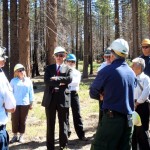Tahoe fire officials plead for cash from congressman
By Kathryn Reed
With charred trees all around him and having driven through much of the neighborhood that will forever be scarred by the Angora Fire, Rep. Tom McClintock took it all in.
“I’m in fact finding mode right now,” the Republican from Granite Bay said at the end of Tuesday’s tour.

Rep. Tom McClintock, center, listens to Lake Tahoe Basin fire officials Sept. 7. Photos/Kathryn Reed
He would make no statement how he might help bring more cash to the Lake Tahoe Basin to help create a healthier forest. But he does favor allowing timber to be harvested so the cash that comes from that work would pay for the harvest or thinning.
“This excess timber will come out one way or another. It will either be carried out or burned,” McClintock said.
The congressman started the day on the West Shore to see what lingers from the August 2007 Washoe Fire that was started when barbecue flames got out of hand. Five homes and nearly 20 acres were destroyed.
A contingent of fire officials from throughout the Lake Tahoe Basin escorted McClintock on the tour, pointing out how the West Shore was not treated and how parts of the Angora burn area had been.
Walking in near the end of Zuni Street in an outfit better suited for the halls of the Capitol than the forest of Tahoe, McClintock was surrounded by charred trees. Some have blue paint patches, signifying they will soon be felled.
This section of the June 2007 fire that reduced 254 houses to ash and burned nearly 3,100 acres is close to the ignition point of the illegal campfire.
“If the SEZ (stream environmental zone) had been treated it would have reduced the impact to the houses downwind and downstream,” Kit Bailey, fire chief for the U.S. Forest Service in Tahoe, said.
This means had there been funding for more thinning and had the agencies been playing nicer at the time to allow for such work, maybe some of the destroyed houses would still be standing.
The Sept. 7 field trip was all about lobbying the congressman for money. He is on the Natural Resources Committee. For that committee he is the lead Republican on the Subcommittee on Water and Power, and he is also a member of the National Parks, Forests and Public Lands Subcommittee.
The fire officials were able to the get the ear of Sens. Harry Reid, D-Nev., John Ensign, R-Nev., and Dianne Feinstein, D-Calif., when they were in the area last month for the annual environmental summit. (No one can remember the last time Sen. Barbara Boxer, D-Calif., set foot in Tahoe.)
With McClintock’s side of Congress being responsible for appropriations, his support will be key when reauthorization of the Lake Tahoe Restoration Act comes up for a vote. This piece of legislation would bring $415 million to the Lake Tahoe Basin over eight years. A chunk of it would go to fuel reduction projects.
The Forest Service gets a base amount of cash each year for these projects, but it fluctuates. It’s stimulus money and cash from Southern Nevada Public Lands Management Act that have helped the USFS and local fire agencies to thin as much as they have. But both of those supplies are running dry.
This year the Forest Service expects to treat 2,000-3,000 acres mechanically and another 1,000-1,500 acres by hand.
Lake Valley Fire Chief Jeff Michael told McClintock how his department has money to fund two year’s worth of projects. If more is not secured, he expects that 20-person team will be out of work.
“Eventually we are going to run out of state and federal funds and it will be up to the land owner,” Duane Whitelaw, North Tahoe Fire Department chief, told Lake Tahoe News. “Some of the challenges fire districts have is we don’t own the land we’re treating.”
It is California Tahoe Conservancy and state parks property he is talking about.
Bill Holmes, unit chief with CalFire, spoke a bit about how the building code regulations that went into affect Jan. 1, 2008, are a step in the right direction, but he wishes wood decks had been banned.
“Wood decks are the first thing to catch fire,” Holmes said to the group standing in the forest. “If that catches fire, the house catches fire.”
He said the decks are a greater threat than shake roofs because the number of shake roofs is minimal now.
Dennis Cocking with South Tahoe Public Utility District was on the tour giving a bit of history how his agency had put in about $18 million in infrastructure improvements to the area before the fire hit. That allowed water flow to be continuous.
On an average day the agency produces 12.5 million gallons of water. On June 24, 2007, the first day of the Angora Fire, 24 million gallons were produced.
“That’s why infrastructure improvements are so critical,” Cocking said.
South Tahoe PUD is hoping for cash from the LT Restoration Act, too.
For the fire districts, this is the third year of a 10-year abatement plan. The problem is, without more money, the plan won’t be finished. Whitelaw said the purpose of having McClintock walk in the forest was to see what wildfires can do, but also see what thinning projects can do.

